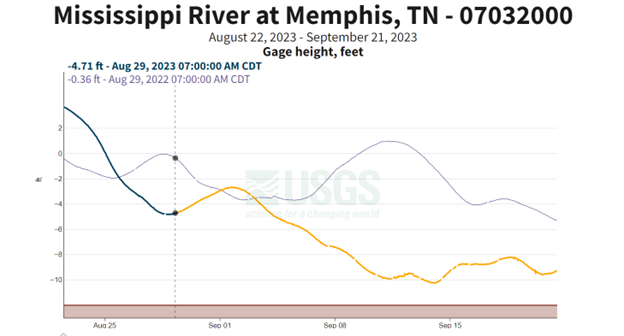Woes on the Mighty Mississippi could worsen
Recent precipitation fails to replenish waterway, leading to traffic delays and restrictions.

Despite receiving precipitation in drought-plagued areas of the Mississippi Valley and the Corn Belt, USDA meteorologist Brad Rippey said this week that not a lot of runoff made it to the extremely low Mississippi River.
“A lot of that moisture went into the landscape—in other words, for crops—and we have not seen enough runoff to at least fully alleviate the drought situation,” he said.
Low river levels along areas of the Mississippi River Basin for the second consecutive year have caused some disruptions to barge traffic as well as some barge restrictions.
“Until appreciable rain falls across the basin, including the Ohio River, the Upper Mississippi, and the Missouri Basin, and we start to get some water runoff into the main channel, this low water problem will continue and could get considerably worse,” according to Rippey.
In Caruthersville, Mo., levels on Sept. 12 even surpassed the record-low levels seen last year, measuring at -2.28 ft. This was down even further from -1.82 ft. on Oct. 16, 2022. Another key area, the Mississippi River at Memphis, Tenn., on Sept. 21 had fallen to -9.39 ft., which is just a little over the all-time record low of -10.81 ft. on Oct. 21, 2022.

Rippey said over the last year there has been considerable effort by the U.S. Army Corps of Engineers to try to widen, dredge, and deepen the river, which has helped. However, as the situation continues to worsen, it does create a scenario where barge loads have to be lightened in order to navigate the waterway.
The U.S. Department of Agriculture’s weekly “Grain Transportation Report” relayed that transit delays of two to three days are occurring between Cairo, Ill., and the U.S. Gulf as loading drafts for barges are down 24% from normal and tow sizes are down 17-38% from normal. Additionally, loading drafts on the Illinois River and Mid-Mississippi River have been reduced by 15%. Tow size has also been reduced between St. Louis, Mo., and Cairo, Ill.
Barge rates have been rising sharply as a result. USDA reported that barge rates originating at St. Louis have risen 376% sine June 6, to $38.34/ton on Sept. 19. This is slightly higher than the rate of $38.10/ton during the same period last year. Mid-Mississippi barge rates on Sept. 19 were $45.38/ton, up from $14.95/ton on June 6. Cairo-Memphis barge rates on Sept. 19 were $32.44/ton, up from $6.56/ton on June 6.
As “game time” is here again for crop farmers and the entire agriculture industry, Soy Transportation Coalition executive director Mike Steenhoek said it is unfortunate that the U.S. inland waterway system is not operating from a position of strength again this year.
“I was hopeful that 2023 would not present a sequel to the historically low water levels on the Mississippi River in 2022, but unfortunately that clearly is occurring,” he said. “During this period, we need our supply chain, including the Mississippi River, to be operating at full capacity. The current low water conditions are therefore clearly a cause for concern.”
About the Author(s)
You May Also Like





